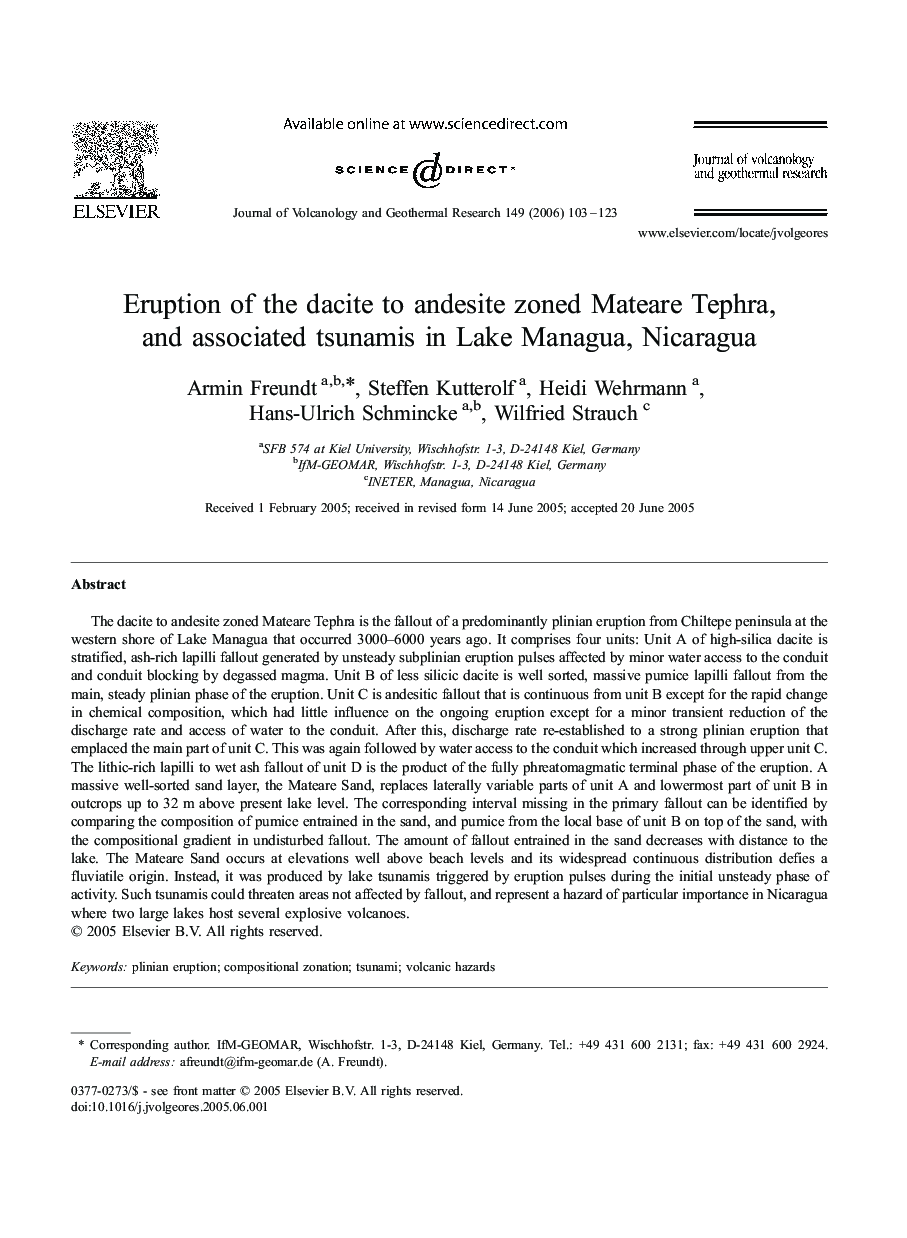| کد مقاله | کد نشریه | سال انتشار | مقاله انگلیسی | نسخه تمام متن |
|---|---|---|---|---|
| 4714928 | 1638487 | 2006 | 21 صفحه PDF | دانلود رایگان |
عنوان انگلیسی مقاله ISI
Eruption of the dacite to andesite zoned Mateare Tephra, and associated tsunamis in Lake Managua, Nicaragua
دانلود مقاله + سفارش ترجمه
دانلود مقاله ISI انگلیسی
رایگان برای ایرانیان
موضوعات مرتبط
مهندسی و علوم پایه
علوم زمین و سیارات
ژئوشیمی و پترولوژی
پیش نمایش صفحه اول مقاله

چکیده انگلیسی
The dacite to andesite zoned Mateare Tephra is the fallout of a predominantly plinian eruption from Chiltepe peninsula at the western shore of Lake Managua that occurred 3000-6000 years ago. It comprises four units: Unit A of high-silica dacite is stratified, ash-rich lapilli fallout generated by unsteady subplinian eruption pulses affected by minor water access to the conduit and conduit blocking by degassed magma. Unit B of less silicic dacite is well sorted, massive pumice lapilli fallout from the main, steady plinian phase of the eruption. Unit C is andesitic fallout that is continuous from unit B except for the rapid change in chemical composition, which had little influence on the ongoing eruption except for a minor transient reduction of the discharge rate and access of water to the conduit. After this, discharge rate re-established to a strong plinian eruption that emplaced the main part of unit C. This was again followed by water access to the conduit which increased through upper unit C. The lithic-rich lapilli to wet ash fallout of unit D is the product of the fully phreatomagmatic terminal phase of the eruption. A massive well-sorted sand layer, the Mateare Sand, replaces laterally variable parts of unit A and lowermost part of unit B in outcrops up to 32 m above present lake level. The corresponding interval missing in the primary fallout can be identified by comparing the composition of pumice entrained in the sand, and pumice from the local base of unit B on top of the sand, with the compositional gradient in undisturbed fallout. The amount of fallout entrained in the sand decreases with distance to the lake. The Mateare Sand occurs at elevations well above beach levels and its widespread continuous distribution defies a fluviatile origin. Instead, it was produced by lake tsunamis triggered by eruption pulses during the initial unsteady phase of activity. Such tsunamis could threaten areas not affected by fallout, and represent a hazard of particular importance in Nicaragua where two large lakes host several explosive volcanoes.
ناشر
Database: Elsevier - ScienceDirect (ساینس دایرکت)
Journal: Journal of Volcanology and Geothermal Research - Volume 149, Issues 1â2, 1 January 2006, Pages 103-123
Journal: Journal of Volcanology and Geothermal Research - Volume 149, Issues 1â2, 1 January 2006, Pages 103-123
نویسندگان
Armin Freundt, Steffen Kutterolf, Heidi Wehrmann, Hans-Ulrich Schmincke, Wilfried Strauch,